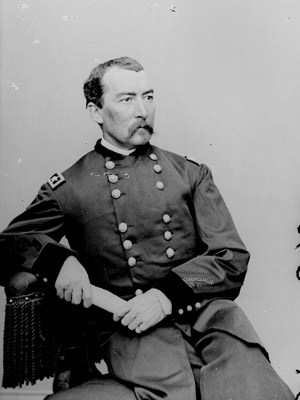
Library of Congress Photo Phillip Henry Sheridan was born on March 6, 1831—that much is known. On various occasions, he mentions his place of birth as Boston, Somerset County, Ohio, and Albany, New York, although he also may have been born in Ireland or at sea during his parent's emigration to the United States. It is known that Sheridan received his early education in Somerset and entered the US Military Academy at West Point from that town in 1848 after lying about his age. His career as a cadet got off to a shaky start when Sheridan, who was known for his hair-trigger temper and nicknamed "Little Phil" due to his shortness—he stood five feet, five inches tall, with a huge torso and short, bandy legs—assaulted an upperclassman, which resulted in his suspension for one year. He graduated in 1853, ranked thirty-four in a class of forty-nine. Sheridan was also commissioned a second lieutenant in the 1st US Infantry and assigned to duty fighting Indians along the Rio Grande in Texas. In 1854, he joined the 4th US Infantry and moved to Oregon to participate in a futile campaign against the Yakima Indians. Second Lieutenant Sheridan narrowly escaped death in March 1856 when he led forty dragoons against the Cascade Indians, who had captured a blockhouse near Dallas on the Columbia River. He spent the next five years on the Grand Ronde Indian Reservation living most of the time with a Rogue River Indian woman. At the outbreak of the Civil War, Sheridan was called east to serve as a captain in the 13th US Infantry in southwest Missouri. In late May 1862, he was appointed colonel of the 2nd Michigan Cavalry, and just over one month later, distinguished himself during a raid at Booneville, Mississippi. The army desperately needed aggressive officers, and Sheridan was rewarded with an appointment to brigadier general and command of an infantry division in Buell's Army of the Ohio. In March 1863, Sheridan at the age of thirty-two, was promoted to major general of volunteers on December 31, 1862. Sheridan campaigned in central Tennessee with General Rosecrans throughout the remainder of 1863. In 1864, Lieutenant General Ulysses S. Grant, made Sheridan—although most of his background was in infantry—Chief of the Cavalry in the Army of the Potomac, which included three divisions of 10,000 horsemen. Sheridan will meet Brigadier General George Armstrong Custer, Commander of the Michigan Brigade, for the first time on April 15, 1864. Custer became one of Sheridan's most trusted lieutenants throughout the remainder of the war, and the two men established a warm friendship that endured until Custer's death. General Sheridan quickly overhauled the cavalry from its traditional mission of battlefield support into a mobile, hard-hitting strike force. In August 1864, Sheridan was assigned command of the Army of the Shenandoah, with orders to wreak havoc upon this valley that had been the main source of supplies for the Rebel army. A strategy of "Total War," a reign of terror on the civilian populace designed to deny the enemy army comfort and sustenance was implemented with great success. Sheridan resumed his raiding tactics in the spring of 1865, and by April, the Army of Northern Virginia had been for all intents and purposes beaten into submission—with much of the glory showered upon the efforts of the cavalry. Sheridan purchased the table on which the surrender was signed and presented it to Libby Custer in honor of her husband. Immediately following the war, General Sheridan was dispatched in command of more than 50,000 troops along the Rio Grande in Texas as a show of strength to the French, who had invaded Mexico. Sheridan was put in command of the 5th Military District, encompassing Texas and Louisiana, on Reconstruction duty. At this time he helped Custer, who was serving him in Texas; obtain the lieutenant colonelcy of the 7th US Cavalry. In February of 1868, Sheridan assumed command of the Department of Missouri and became responsible for enforcing the peace among the hostile Plains Indian tribes. He implemented the "Total War" strategy in the winter campaign of 1868-1869 against the Southern Cheyenne, Arapaho, Kiowa, and Comanche. Sheridan recalled Custer early from his suspension to lead the campaign, which was successful in driving the Southern Plains tribes onto reservations. Sheridan's standing orders to Custer were, "To kill all the warriors, capture all the women and children, destroy all camps and material goods, and kill all the ponies." In 1869, when General William Tecumseh Sherman was made General-in-Chief of the US Army, Sheridan was promoted to lieutenant general and assumed command of the Military District of Missouri, which extended from the Mississippi River west to the Rocky Mountains north and south from Canada to Mexico borders. He was involved in the Red River Wars of 1874-75, the Great Sioux Wars of 1876-77, and the Nez Perce War of 1877. Sheridan became General-in-Chief of the US Army in November 1883 when General Sherman retired. In that capacity, he brought the bloody period of the American Indian wars to an end with the capture of Geronimo in 1886. Phillip Henry Sheridan was made a four-star general shortly before he died in office at the age of fifty-seven on August 5, 1888, in Norquitt, Massachusetts. He was survived by his wife, son, and three daughters. |
Last updated: August 7, 2020
